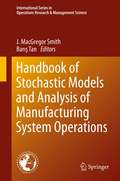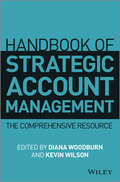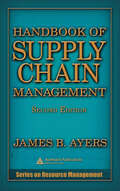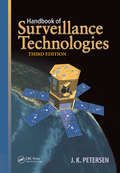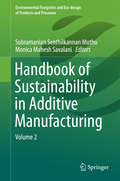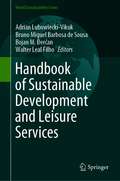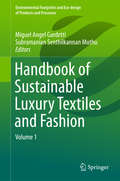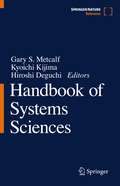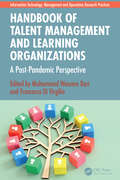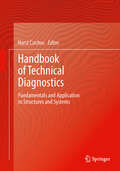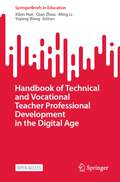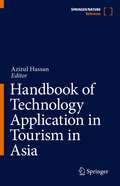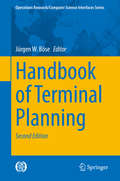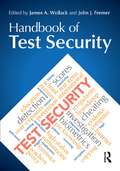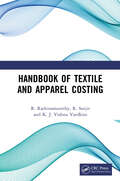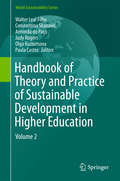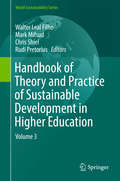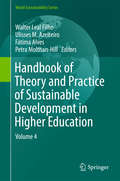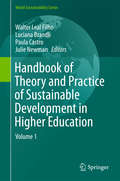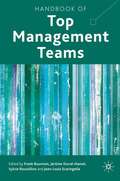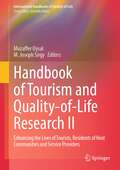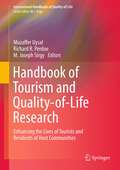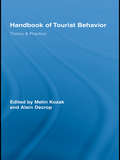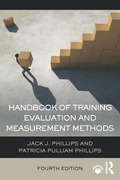- Table View
- List View
Handbook of Stochastic Models and Analysis of Manufacturing System Operations
by Barış Tan J. Macgregor SmithThis handbook surveys important stochastic problems and models in manufacturing system operations and their stochastic analysis. Using analytical models to design and control manufacturing systems and their operations entail critical stochastic performance analysis as well as integrated optimization models of these systems. Topics deal with the areas of facilities planning, transportation, and material handling systems, logistics and supply chain management, and integrated productivity and quality models covering: * Stochastic modeling and analysis of manufacturing systems * Design, analysis, and optimization of manufacturing systems * Facilities planning, transportation, and material handling systems analysis * Production planning, scheduling systems, management, and control * Analytical approaches to logistics and supply chain management * Integrated productivity and quality models, and their analysis * Literature surveys of issues relevant in manufacturing systems * Case studies of manufacturing system operations and analysis Today's manufacturing system operations are becoming increasingly complex. Advanced knowledge of best practices for treating these problems is not always well known. The purpose of the book is to create a foundation for the development of stochastic models and their analysis in manufacturing system operations. Given the handbook nature of the volume, introducing basic principles, concepts, and algorithms for treating these problems and their solutions is the main intent of this handbook. Readers unfamiliar with these research areas will be able to find a research foundation for studying these problems and systems.
Handbook of Strategic Account Management
by Kevin Wilson Diana WoodburnA compilation of the established knowledge in strategic account managementWhile companies and academics expend tremendous effort on mass marketing, they often overlook their immediate customers (which are critical in both senses) and hence the importance of strategic account management (SAM). This handbook is a compilation of papers that present researched knowledge of SAM across the academic community which fills a void in the existing academic literature. Handbook of Strategic Account Management identifies drivers of the SAM approach, key issues and success factors, operational needs and areas still awaiting exploration. Each paper includes an overall referenced summary of the tenets of SAM relevant to the area it reports, and together with the combined list of references, it creates an indispensable resource for academic readers, students, and researchers.Handbook of Strategic Account Management is written by over 40 knowledgeable experts with substantial experience of SAM from teaching, researching, writing and advising companies on why and how it works, spread widely across Europe and the US. It represents the balanced, researched body of knowledge in SAM and will be an invaluable resource to anyone exploring the approach, whether for a student thesis, for original research or for answers on how to approach SAM as a company initiative."Today's strategic, key and global account management professionals owe thanks to a small community of academic researchers who, over the past three decades have been pioneers in identifying, cataloguing and analyzing the selling and business management practices of an emerging profession we now call strategic account management. This Handbook is an important milestone to mark SAM's still evolving impact on corporate business strategies and its ever-increasing relevance as a proven engine for growth in business-to-business strategic customer relationships."Bernard Quancard,President & CEO of SAMA (US-based Strategic Account Management Association with over 3,000 members worldwide)Yana Atanasova Bjorn Ivens Toni Mikkola Ivan Snehota Audrey Bink Ove Jensen Stefanos Mouzas Kaj Storbacka Per-Olof Brehmer Robert Krapfel Peter Naudé Olavi Uusitalo Noel Capon Antonella La Rocca Jukka Ojasalo Tom Vanderbiesen Simon Croom Sylvie Lacoste Catherine Pardo Stefan Wengler Osman Gök Nikala Lane Nigel Piercy Kevin Wilson Paolo Guenzi Régis Lemmens Michael Pusateri Diana Woodburn Stephan Henneburg Tommi Mahlamäki Jakob Rehme John Workman Sue Holt Malcolm McDonald Sanjiy Sengupta George Yip Christian Homburg Florin Mihoc Christoph Senn Judy Zolkiewski
Handbook of Supply Chain Management (Resource Management)
by James B. AyersSupply chain management (SCM) disciplines have produced a flood of new concepts, methods, and tools; if applied wisely, they will improve results. A resource that weeds out and consolidates this new information will lower the business risk of implementing change. Interpreting models and viewpoints from many fields into a supply chain contex
Handbook of Surveillance Technologies
by J.K. Petersen Pamela TaylorFrom officially sanctioned, high-tech operations to budget spy cameras and cell phone video, this updated and expanded edition of a bestselling handbook reflects the rapid and significant growth of the surveillance industry. The Handbook of Surveillance Technologies, Third Edition is the only comprehensive work to chronicle the background and curre
Handbook of Sustainability in Additive Manufacturing
by Subramanian Senthilkannan Muthu Monica Mahesh SavalaniThis book highlights the sustainability aspects of additive manufacturing (AM) in two separate volumes. It describes the details of this technology and its implications on the entire product life cycle sustainability, as well as embedded carbon and the further research needed to move this technology towards sustainable, mainstream production. Sustainability is not new for any area of industry, including additive manufacturing, and there are currently a number of ongoing research projects, both in industry and in academic institutions, that are investigating sustainability, embedded carbon and research activities which would need to be done in the future to move this technology towards sustainable mainstream production.
Handbook of Sustainable Development and Leisure Services (World Sustainability Series)
by Walter Leal Filho Adrian Lubowiecki-Vikuk Bruno Miguel Barbosa de Sousa Bojan M. ĐerčanThis book reviews empirical and theoretical research on sustainable development in the context of leisure management for communities. Although leading research centers are pursuing interdisciplinary research on leisure in the context of sustainable development, there are still few papers that holistically address the current challenges in this area. In addition, demographic changes have made the promotion of a healthy lifestyle essential. Doing so requires responsible behavior on the part of various stakeholders in this market.This book fills an important gap in the literature and gathers contributions from an interdisciplinary and international team of authors, whose fields of expertise include human geography, management, intersections of sustainability and leisure, behavioral psychology and tourism.
Handbook of Sustainable Luxury Textiles and Fashion
by Subramanian Senthilkannan Muthu Miguel Angel GardettiThe second volume of handbook explores different dimensions of the sustainable luxury textiles and fashion, broadly based on the following topics: Sustainable luxury Luxury and consumption Luxury, innovation and design potential Luxury and entrepreneurship Sustainable Luxury Management
Handbook of Systems Sciences
by Kyoichi Kijima Gary S. Metcalf Hiroshi DeguchiThe primary purpose of this handbook is to clearly describe the current state of theories of systems sciences and to support their use and practice. There are many ways in which systems sciences can be described. This handbook takes a multifaceted view of systems sciences and describes them in terms of a relatively large number of dimensions, from natural and engineering science to social science and systems management perspectives. It is not the authors’ intent, however, to produce a catalog of systems science concepts, methodologies, tools, or products. Instead, the focus is on the structural network of a variety of topics. Special emphasis is given to a cyclic–interrelated view; for example, when a theory of systems sciences is described, there is also discussion of how and why the theory is relevant to modeling or practice in reality. Such an interrelationship between theory and practice is also illustrated when an applied research field in systems sciences is explained. The chapters in the handbook present definitive discussions of systems sciences from a wide array of perspectives. The needs of practitioners in industry and government as well as students aspiring to careers in systems sciences provide the motivation for the majority of the chapters. The handbook begins with a comprehensive introduction to the coverage that follows. It provides not only an introduction to systems sciences but also a brief overview and integration of the succeeding chapters in terms of a knowledge map. The introduction is intended to be used as a field guide that indicates why, when, and how to use the materials or topics contained in the handbook.
Handbook of Talent Management and Learning Organizations: A Post-Pandemic Perspective (Information Technology, Management and Operations Research Practices)
by Francesca Di Virgilio Muhammad Waseem BariThis handbook contributes to the advanced knowledge of talent management and learning organizations in the post-pandemic era. It provides new insights and contributions to the existing literature on business organizations through the dissemination of information as well as empirical pieces of evidence from various parts of the world. The focus of this handbook is on advancing talent management strategies and learning organizations through knowledge sharing on various platforms, geographical locations, and diverse groups of intellectuals having diversified experience, knowledge, and expertise. It also focuses on innovation and creativity based on global competition, advanced communication, and management technologies and on changing customers’ behaviors and needs in the post-pandemic era.The Handbook of Talent Management and Learning Organizations: A Post-Pandemic Perspective explores theoretical and empirical artifacts and different approaches to enhance the understanding of the relationship between talent management and learning organization. It provides solutions to managers and consultants who are facing problems while managing talent due to workplace changes post-pandemic and shows the connection between innovation and creativity as talent management enhances organizational learning, knowledge-sharing culture, innovation capabilities, and creativity. The handbook also offers strategies and solutions to manage talent virtually and presents future research directions and solutions to contemporary issues related to talent management and learning organizations moving forward.This handbook targets graduate students, research scholars, practitioners, employees, consultants, corporate bodies, and technocrats. It will be very helpful to managers and consultants who are facing problems with managing talent due to workplace changes after the pandemic.
Handbook of Technical Diagnostics: Fundamentals and Application to Structures and Systems
by Horst CzichosThis book presents concepts, methods and techniques to examine symptoms of faults and failures of structures, systems and components and to monitor functional performance and structural integrity. The book is organized in five parts. Part A introduces the scope and application of technical diagnostics and gives a comprehensive overview of the physics of failure. Part B presents all relevant methods and techniques for diagnostics and monitoring: from stress, strain, vibration analysis, nondestructive evaluation, thermography and industrial radiology to computed tomography and subsurface microstructural analysis. Part C cores the principles and concepts of technical failure analysis, illustrates case studies, and outlines machinery diagnostics with an emphasis on tribological systems. Part D describes the application of structural health monitoring and performance control to plants and the technical infrastructure, including buildings, bridges, pipelines, electric power stations, offshore wind structures, and railway systems. And finally, Part E is an excursion on diagnostics in arts and culture. The book integrates knowledge of basic sciences and engineering disciplines with contributions from research institutions, academe, and industry, written by internationally known experts from various parts of the world, including Europe, Canada, India, Japan, and USA.
Handbook of Technical and Vocational Teacher Professional Development in the Digital Age (SpringerBriefs in Education)
by Ming Li Yuping Wang Xibin Han Qian ZhouThis is an open access book. Covering both theories and practices in Technical Vocational Education and Training (TVET) teacher development, this book provides up-to-date discussions and recommendations on issues relating to TVET teacher development in the digital age. It caters for the needs of in-service teachers and trainers, as well as TVET leaders who want to upscale their professional learning and development in terms of vision, knowledge, expertise, and industry skills needed in the transition to the digital era.What is particularly useful to TVET teachers/trainers are the proposed competency development framework, competency indicators, and the assessment instrument. Drawing on extensive research regarding TVET teachers’ competency development and today’s industry needs, the proposed framework and indicators can be readily used to inform the self-assessment of one’s professional competency level, so as to plan one’s career trajectory accordingly. Teachers and trainers may also find the exemplary cases of teachers’ professional development from various countries inspiring and motivating. The book also serves as a useful reference for TVET leaders, administrators and teacher trainers. The book's competency framework, indicators, and strategies are an adaptable reference for planning professional development policies, evaluation mechanisms, and programs for teachers.
Handbook of Technology Application in Tourism in Asia
by Azizul HassanIt is an undisputed reality that the tourism industry in Asia is getting exposed to more innovative technologies than ever before. This proposed book provides the latest research in the application of innovative technology to the tourism industry, covering the perspectives, innovativeness, theories, issues, complexities, opportunities and challenges. This book, a blend of comprehensive and extensive effort by the contributors and editors, is designed to cover the application and practice of technology in tourism, including the relevant niches. This book focuses on the importance of technology in tourism. This also highlights, in a comprehensive manner, specific technologies that are impacting the tourism industry in Asia, as well as the constraints the industry is facing. The contents of this book deal with distinct topics, such as mobile computing, new product designs, innovative technology usages in tourism promotion, technology-driven sustainable tourism development, location-based apps, mobility, accessibility and so on. A good number of research studies have conducted outlining the contributions and importance of technologies in tourism, in general. However, the tourism industry of Asia so far has attracted very few researchers. Some contributions have been made but not sufficient. Considering the ongoing trend of technology application in the tourism industry in Asia, very few research attempts have been made aiming to explore diverse aspects. Tourism is expanding enormously across the world. which actually creates more demands for effective technologies. This book will be a reading companion, especially for tourism students in higher academic institutions. This book will also be read by the relevant policy planners and industry professionals. Apart from them, this book will be appreciated by expatriate researchers and researchers having keen interest in the Asian tourism industry.
Handbook of Technology in Financial Services
by Jessica KeyesThe calculus of IT support for the banking, securities and insurance industries has changed dramatically and rapidly over the past few years. Unheard of just a few years ago, corporate intranets are now used for everything from job postings to enhanced team communications. Whole new departments are being created to support e-commerce. And the Internet/Intranet/Extranet triple-whammy is the most critical component of most financial IT shops. At the same time, intelligent agents stand ready to take on such diverse functions as customer profiling and data mining.
Handbook of Terminal Planning (Operations Research/Computer Science Interfaces Series)
by Jürgen W. BöseSeaport Container Terminals (SCT) operate as central nodes in worldwide hub-and-spoke networks, and link ocean-going vessels with smaller feeder vessels, as well as with inbound and outbound hinterland transportation systems using road, rail, or inland waterways. The volume of transcontinental container flows has gained enormously over the last five decades frequently leading to double-digit annual growth rates for the SCT. The 2nd edition of the Handbook of Terminal Planning also deals with problems being induced by questions of terminal development on a long-term basis (strategic level). Facing present and upcoming challenges for SCT operation—such as more and more mega vessels, extremely high hinterland peaks, higher environmental standards, less public acceptance and the stronger competition between terminals serving the same hinterland—the focus of the book is on successful approaches and solutions primarily addressing the planning of terminal structures. Nevertheless, operational aspects are considered, as well as how they effectively contribute to problem solving on the strategic level.
Handbook of Test Security
by James A. Wollack John J. FremerHigh stakes tests are the gatekeepers to many educational and professional goals. As such, the incentive to cheat is high. This Handbook is the first to offer insights from experts within the testing community, psychometricians, and policymakers to identify and develop best practice guidelines for the design of test security systems for a variety of testing genres. Until now this information was scattered and often resided inside testing companies. As a result, rather than being able to learn from each other’s experiences, each testing entity was left to re-create their own test security wheel. As a whole the book provides invaluable insight into the prevalence of cheating and “best practices” for designing security plans, training personnel, and detecting and investigating misconduct, to help develop more secure testing systems and reduce the likelihood of future security breaches. Actual case studies from a variety of settings bring to life how security systems really work. Examples from both domestic and international programs are provided. Highlights of coverage include:• Best practices for designing secure tests• Analysis of security vulnerabilities for all genres of testing• Practical cheating prevention and detection strategies• Lessons learned in actual security violations in high profile testing programs. Part I focuses on how tests are delivered for paper-and-pencil, technology-based, and classroom testing and writing assessment. Each chapter addresses the prevalence of the problem and threats to security, prevention, and detection. Part II addresses issues essential to maintaining a secure testing program such as planning and monitoring, physical security, the detection of group-based cheating, investigating misconduct, and communicating about security-related issues. Part III examines actual examples of cheating-- how the cheating was done, how it was detected, and the lessons learned. Part III provides insight into security issues within each of the Association of Test Publishers’ four divisions: certification/licensure, clinical, educational, and industrial/organizational testing. Part III’s conclusion revisits the issues addressed in the case studies and identifies common themes. Intended for organizations, professionals, educators, policy makers, researchers, and advanced students that design, develop, or use high stakes tests, this book is also ideal for graduate level courses on test development, educational measurement, or educational policy.
Handbook of Textile and Apparel Costing
by R. Rathinamoorthy R. Surjit K. J. VardhiniHandbook of Textile and Apparel Costing covers a wider area of the costing aspects of industrial and academic requirements from spinning to the apparel sector.It is a one of its kind in the textile and fashion discipline that covers the cost calculation methods of every manufacturing step in entirety: spinning, weaving, processing, and apparel manufacturing.Print edition not for sale in South Asia (Bangladesh, Bhutan, India, Nepal, Pakistan and Sri Lanka)
Handbook of Theory and Practice of Sustainable Development in Higher Education
by Walter Leal Filho Paula Castro Olga Kuznetsova Constantina Skanavis Arminda Do Paço Judy RogersThis Handbook approaches sustainable development in higher education from an integrated perspective, addressing the dearth of publications on the subject. It offers a unique overview of what universities around the world are doing to implement sustainable development (i. e. via curriculum innovation, research, activities, or practical projects) and how their efforts relate to education for sustainable development at the university level. The Handbook gathers a wealth of information, ideas, best practices and lessons learned in the context of executing concrete projects, and assesses methodological approaches to integrating the topic of sustainable development in university curricula. Lastly, it documents and disseminates the veritable treasure trove of practical experience currently available on sustainability in higher education.
Handbook of Theory and Practice of Sustainable Development in Higher Education
by Walter Leal Filho Mark Mifsud Chris Shiel Rudi PretoriusThis Handbook approaches sustainable development in higher education from an integrated perspective, addressing the dearth of publications on the subject. It offers a unique overview of what universities around the world are doing to implement sustainable development (i. e. via curriculum innovation, research, activities, or practical projects) and how their efforts relate to education for sustainable development at the university level. The Handbook gathers a wealth of information, ideas, best practices and lessons learned in the context of executing concrete projects, and assesses methodological approaches to integrating the topic of sustainable development in university curricula. Lastly, it documents and disseminates the veritable treasure trove of practical experience currently available on sustainability in higher education.
Handbook of Theory and Practice of Sustainable Development in Higher Education
by Walter Leal Filho Ulisses M. Azeiteiro Fátima Alves Petra Molthan-HillThis Handbook approaches sustainable development in higher education from an integrated perspective, addressing the dearth of publications on the subject. It offers a unique overview of what universities around the world are doing to implement sustainable development (i. e. via curriculum innovation, research, activities, or practical projects) and how their efforts relate to education for sustainable development at the university level. The Handbook gathers a wealth of information, ideas, best practices and lessons learned in the context of executing concrete projects, and assesses methodological approaches to integrating the topic of sustainable development in university curricula. Lastly, it documents and disseminates the veritable treasure trove of practical experience currently available on sustainability in higher education.
Handbook of Theory and Practice of Sustainable Development in Higher Education
by Walter Leal Filho Luciana Brandli Paula Castro Julie NewmanThis Handbook approaches sustainable development in higher education from an integrated perspective, addressing the dearth of publications on the subject. It offers a unique overview of what universities around the world are doing to implement sustainable development (i. e. via curriculum innovation, research, activities, or practical projects) and how their efforts relate to education for sustainable development at the university level. The Handbook gathers a wealth of information, ideas, best practices and lessons learned in the context of executing concrete projects, and assesses methodological approaches to integrating the topic of sustainable development in university curricula. Lastly, it documents and disseminates the veritable treasure trove of practical experience currently available on sustainability in higher education.
Handbook of Top Management Teams
by Frank Bournois Jérôme Duval-Hamel Sylvie Roussillon Jean-Louis ScaringellaQuestions of company governance have been examined over the years, but this has generally been in areas concerning shareholders. Meanwhile the management team and board of directors remain comparatively unexplored. This book has been written to provide a way into this relatively unknown world of executive committees.
Handbook of Tourism and Quality-of-Life Research II: Enhancing the Lives of Tourists, Residents of Host Communities and Service Providers (International Handbooks of Quality-of-Life)
by Muzaffer Uysal M. Joseph SirgyThe second volume of this handbook develops on and extends the discussion in the successful first volume, published in 2012. This is a timely addition to the literature, drawing on the momentum that quality of life (QOL) research in tourism has gained in the 21st century and on the boom in the tourism industry itself. It focuses on four areas of growth in QOL research in the recent past: (1) travelers/tourists, (2) host communities, (3) service providers, and (4) the role of technology. The handbook helps management of tourism firms and policy makers develop specific policies and programs to ensure the most positive impact of tourism on tourists, host communities, and service providers. The comprehensive coverage of topics in this handbook makes it a state-of-the-art reference. Academics interested in QOL research in travel and tourism, tourism practitioners interested in applying the science of QOL in the tourism industry, as well as policy makers involved in regulating the industry will view the handbook as indispensable source of recent research.
Handbook of Tourism and Quality-of-Life Research: Enhancing the Lives of Tourists and Residents of Host Communities
by Muzaffer Uysal M. Joseph Sirgy Richard PerdueQuality of life (QOL) research in tourism has gained much momentum over the last two decades. Academics working in this area research issues related to tourists and host communities. Practitioners are becoming increasingly interested in understanding the science that allows them to develop better marketing and managerial programs designed to enhance the quality of life of tourists. Tourism bureaus and government agencies are increasingly interested in issues of sustainable tourism, specifically in understanding and measuring the impact of tourism on the quality of life of the residents of the host communities. This handbook covers all relevant topics and is divided into two parts: research relating to travelers/tourists, and research relating to the residents of host communities. It is the only state-of-the-art reference book in its field and will prove invaluable to academics interested in QOL research, as well as tourism practitioners interested in applying the science of QOL in the tourism industry.
Handbook of Tourist Behavior: Theory & Practice (Routledge Advances in Tourism)
by Alain Decrop Metin KozakIn today’s highly competitive and global economy, understanding tourist behavior is imperative to success. Tourist behavior has become a cornerstone of any marketing strategy and action. Choosing, buying and consuming tourism/travel products and services includes a range of psycho-social processes and a number of personal and environmental influences that researchers and managers should take into account. This book provides an overview of such processes and influences and explains the basic concepts and theories that underlie tourist decision-making and behavior. It also incorporates a number of cases studies in order to aid readers to better appraise the application of those concepts and theories. The Handbook of Tourist Behavior will be of significant interest to researchers and students in tourism, leisure, marketing and psychology, and also to practitioners in the tourism industry.
Handbook of Training Evaluation and Measurement Methods: Instructor's Guide (Improving Human Performance Ser.)
by Jack J. Phillips Patricia Pulliam PhillipsToday’s economic climate means that anyone involved in training and development must be able to measure its effect on business performance. With a focus on costs, benefits, and return on investment, this book provides a comprehensive reference for those who are learning about or implementing an evaluation system. This new edition is fully revised and updated to reflect current developments, with step-by-step guidance on a range of vital topics, including: Developing a results-based approach to HRD Evaluation design Data collection and measuring success Calculating program costs and ROI Increasing management support for HRD programs. With end-of-chapter discussion questions and an accompanying online Instructor Guide, this fourth edition provides sound theory and practical solutions. The Handbook of Training Evaluation and Measurement Methods is a complete and detailed reference guide suitable for HRD professionals and students in advanced courses in HRD, training evaluation, and program evaluation.
